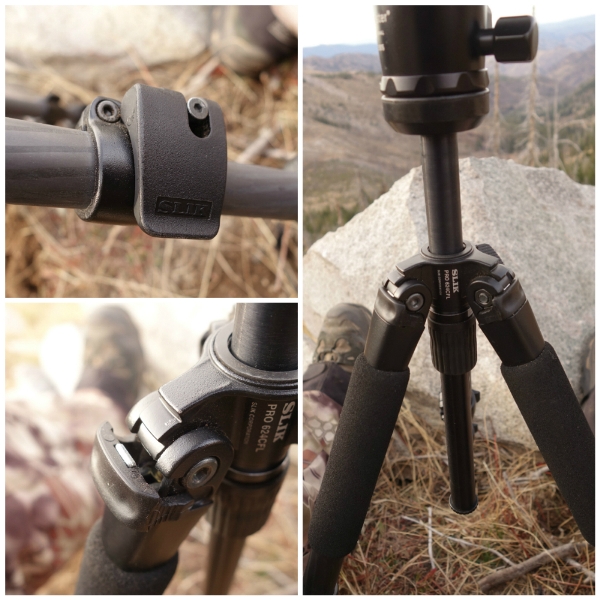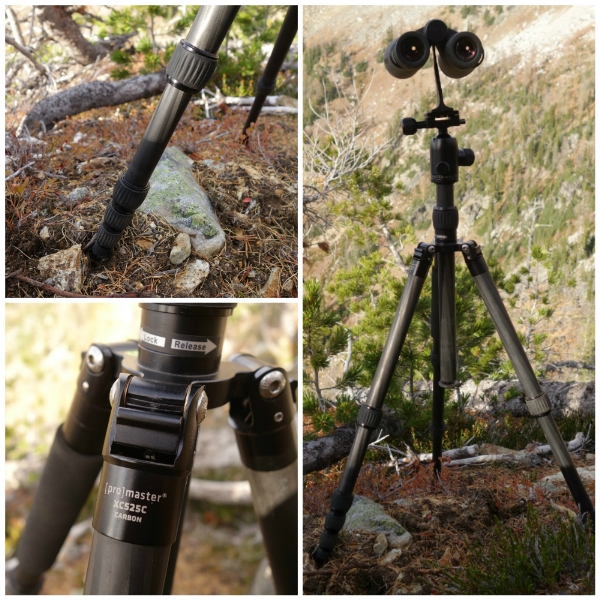
Backcoukntry Tripods: Slik 624 vs Promaster XC525C
By Brock Akers, Rokslide Moderator
These are two very popular tripods on the market today. Both carbon fiber and both priced relatively close. I decided to put them head to head to see to what they were all about and if there was definite better choice between the two. Here’s my list of specifics that I wanted to compare:
• Overall construction
• Weight
• Packability
• Versatility
• Use of the locks (flick vs twist)
• How they handled optics (spotters and binoculars).
Because I wanted a constant for the tripod head, I elected to use the ball head that comes with the Promaster on both tripods.
Slik 624
Rokslide sponsor 1-Shot Gear supplied this tripod for testing. This model of the Slik has been a pretty popular choice for the backpacking crowd the last few years, and for a good reason. With a price point of $229, it’s affordable. With four leg sections, the Slik 624 reaches a max height of 43.5″ with the 10.25″ aluminum center post extended all the way up. I found that this height was just a little short for effective glassing while standing.
There is a neat little feature about the center post; it unscrews into two sections, giving you a 2.75″ height option. This allows the tripod to lay flat for low-profile photography. Each leg has independent locking systems that allow for three different positions for a wide variety of stance options. The legs are made up of 8-layer carbon fiber while the lock bodies & the leg hinges are made of a cast aluminum. This tripod is plenty strong for any task asked of it.

The Slik 624 tested in this review
After a week of business in the high country with this tripod, a few things stood out to me. I was impressed with how nice and compact this tripod gets and how it stashed in my Kifaru pack with ease. I also liked how simple it was to reach down and flick all the locks on a leg simultaneously, especially with gloves on. Weighing in at 35.5 oz (no head,) it was middle of the road on weight. It handled my Maven B2’s well and my Vortex Razor 85mm spotter just fine.

The Slik 624 paired with the Vortex 85mm Spotter. The Slik also handled the Maven B2 Binoculars with ease
A couple things did have me worried about the Slik 624. The pull locks for leg positioning are made of plastic. The actual lock itself is a small piece of metal, but the way you operate it, you are pulling and pushing on plastic. Not a huge deal, but I see that being a potential weak point in the system. Another is the flick lock system in its entirety . While easy to operate with one hand, there is a lot going on down there. We are looking at (6ea) bolts, washers & nuts per leg. Not to mention a spring in each lock. That’s (27ea) mechanical parts that cause you a headache if something failed. The actual flick itself is also made of plastic. If it were to get stepped on while opened or dropped, you could be down a lock quickly. None of this is a deal breaker, but when investing in a nicer tripod these are things to think about.
Promaster XC525c
This tripod was supplied by S&S Archery out of Boise, Idaho- another Rokslide sponsor. With a price point of $299, it’s slightly more expensive than its competitor but worth every penny. Built with five leg sections, the XC525c will extend up to 57.75″ with the 12″ carbon fiber center post extended up all the way. Plenty tall for glassing while standing.
The tripod comes with an interchangeable 4.25″ aluminum center post for low-profile photography or the ability to lay the tripod flat. Each leg has an independent locking system that allows for three different stance positions as well as the option to fold back 180 degrees on itself—a nice option for making the tripod more compact. The legs are made up of 9-layer carbon fiber, while the leg hinges and twist lock bodies are machined aluminum billet making the tripod about as strong as you can get while staying lightweight.

The Promaster XC525c
Several trips into the highcountry with the Promaster XC525c in my backpack left me with many good impressions. I decided that I like the twist lock system better than the flick lock system. With a ½ turn of the rubber coated lock, you can completely extend the freed leg. Then with a simple ½ turn, it’s back to tight. The whole system is less bulky and saves weight. The tripod comes in at 32oz (no head) and is the lighter of the two.
The Promaster handled both my Maven B2’s and my Vortex Razor 85mm very well. An added feature is the monopod ability. One of the legs unscrews at the hinge and it can be utilized for a standalone monopod or in my case, used for a trekking pole in one situation.

The Promaster XC525c handled both binoculars and spotters well
I was having a difficult time finding anything that I didn’t like about the Promaster. My biggest complaint would have to be when you have the legs fully extended and then you want to collapse them. By design, you’re going to have to turn each lock individually—a small price to pay for the quality of this tripod.
No matter which tripod you have with you when you leave the trailhead, you can’t go wrong. But for me, the Promaster XC525c has found a permanent spot in my pack. The attention to detail that went into the machining of the parts and construction of the tripod really sold me. Pair that with the weight and ability to glass while standing and you have a clear winner.
Find out more about the Slik 624 at 1-Shot Gear here or the Promaster XC525c at S&S Archery here.
You can ask Brock questions or discuss this article here

















